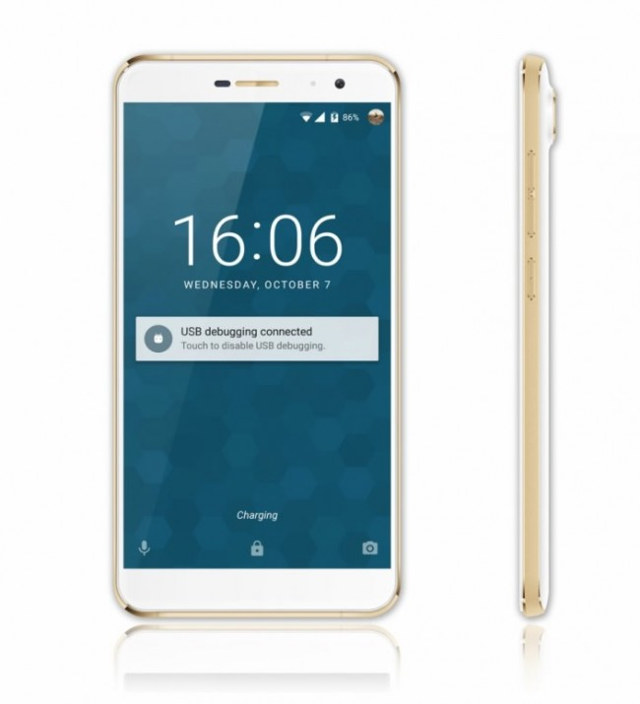Flagship Android smartphones now ship with processors featuring Cortex A72 cores, or custom variants from Samsung or Qualcomm, and normally cost several hundred dollars. Some new smartphones recently announced with MediaTek Helio X20 deca-core processor lower the price barrier in the $250 to $400 range, but at least two upcoming models will bring the cost below $200: Doogee P7 ($169.99), and Vernee Apollo Lite ($199.99). So let’s see what we’ve got for those prices.
Doogee P7
 Doogee P7 (preliminary) Specifications:
Doogee P7 (preliminary) Specifications:
- SoC – Mediatek Helio X20 (MT6797) deca-core processor with 2x Cortex A72 cores @ 2.5 GHz, 4x Cortex A53 cores @ 2.0 GHz, and 4x Cortex A53 cores @ 1.4 GHz and ARM Mali-T880MP GPU @ 850 Mhz
- System Memory – 3GB RAM
- Storage – 16 GB storage and micro SD slot up to 64GB (shared with dual SIM slot)
- Display – 5.5″ capacitive touchscreen, 1920×1080 resolution; 160K colors
- Cellular Connectivity
- 2G – GSM 850/900/1800/1900MHz
- 3G – WCDMA 900/2100MHz
- 4G – FDD LTE Band 1/3/7/8/20
- Dual SIM Card Dual Standby (One Micro SIM Card)
- Connectivity – 802.11 b/g/n WiFi, Bluetooth 4.0, GPS/A-GPS, and FM radio
- Camera – 13.0 MP rear camera with flash and auto-focus, 8.0 MP front-facing camera
- USB – 1x micro USB OTG port
- Audio – Speaker, microphone, and 3.5mm audio jack
- Sensors – gravity, others? (TBD)
- Battery – 3600 mAh battery
- Dimensions – 159.6 x 82.1 x 9.5 mm
- Weight – 170 grams
The phone will run Android 6.0, and ships with a charger and USB cable. You can find some more details on DoogeeMobile, where they show the $169.99 price tag in comments (likely without shipping). There will also be a Doogee P7 Pro version with 32GB storage and 4GB RAM, better camera and display that should sell for $200. It’s unclear when the two versions of the phone will be available, as they keep postponing them.
Vernee Apollo Lite
 Vernee Apollo Lite is the little brother of Vernee Apollo with Helio X20, 6GB RAM, and 128 GB, but selling for half price thanks to lower, but still decent (preliminary) specifications:
Vernee Apollo Lite is the little brother of Vernee Apollo with Helio X20, 6GB RAM, and 128 GB, but selling for half price thanks to lower, but still decent (preliminary) specifications:
- SoC – Mediatek Helio X20 (MT6797) deca-core processor with 2x Cortex A72 cores @ 2.5 GHz, 4x Cortex A53 cores @ 2.0 GHz, and 4x Cortex A53 cores @ 1.4 GHz and ARM Mali-T880MP GPU @ 850 Mhz
- System Memory – 4GB RAM
- Storage – 32 GB storage + micro SD slot
- Display – 5.5″ capacitive touchscreen, 1920×1080 resolution
- Cellular Connectivity – No details yet; Dual SIM Card Dual Standby (SIM + SIM, or SIM + micro SD configuration)
- Connectivity – TBD
- Camera – 16.0 MP rear camera, 5.0 MP front-facing camera
- USB – 1x USB type C port
- Sensors – Compass, gyroscope
- Battery – TBD
- Dimensions – TBD
- Weight – TBD
The phone will also run Android 6.0, and is expected to launch in May for $199.99 + shipping. The company announced the phone on their Facebook page.
Even though the complete specifications are not available for Apollo Lite and Doogee P7, both devices appear to be pretty good smartphones considering the price point.

Jean-Luc started CNX Software in 2010 as a part-time endeavor, before quitting his job as a software engineering manager, and starting to write daily news, and reviews full time later in 2011.
Support CNX Software! Donate via cryptocurrencies, become a Patron on Patreon, or purchase goods on Amazon or Aliexpress





Doogee phones seem to be ok (pretty good even?). What about Vernee?
@onebir
Vernee brand is completely new, but is born from an existing OEM manufacturer. I wrote about the company in http://www.cnx-software.com/2016/03/17/vernee-apollo-smartphone-features-helio-x20-processor-6gb-ram-128gb-storage/:
So I don’t think anybody has bought a Vernee phone so far, at least not under that brand. I can’t find anything about a “Newbund” manufacturer though.
What about Qualcomm? Redmi Note 3?
@Nitin Bhaskar
Redmi Note 3 is Helio X10 (Cortex A53) according to http://www.gearbest.com/cell-phones/pp_268450.html
@cnxsoft
http://www.gsmarena.com/xiaomi_redmi_note_3-7863.php
SD650!
@Nitin Bhaskar
The Pro one has snapdragon the normal one X10, there is just a small price difference between them. Choose what you want yourself.
If you can deal with miui (I really doubt I could) the snapdragon redmi note 3 is almost unbeatable value. And now that it has kernel source and TWRP it might not even necessarily be stuck on miui.
As for me, I’ll stick too nexus.
@Someone from the other side
I have a Redmi Note 2 with an X10 that has 8 X A53 @ 2.2 GHz and I’m quite happy with it, it’s quite a beast and especially shines if apps can use more cores ( I think browsers tend to even use all 8 of them ).
As for MIUI it has it strong points but who says you have to live with it if you don’t like it. I’ve got CM 12.1 running quite nicely on my phone and you can surely find a good CM for Redmi Note 3.
The Redmi Note series might be the best bang for buck you can get from a big manufacturer, especially if you buy from China directly.
Then again cm12 is such a pain on some phones, I replaced a barely 9 month old s5 within a nexus because it war something unstable with cm12 (as for TouchWiz that’s just cruel)
The Redmi Note 3 sold in India has Snapdragon 650 with two A72 cores and four A53 cores. It starts at 9999 INR (149 USD approx) for the 2 GB RAM / 16 GB flash, and 11999 INR (179 USD approx) for 3 GB RAM/32 GB flash. The prices include shipping and all local taxes in India.
@Someone from the other site
Honestly for my Xiaomi Redmi Note 2 I found a ROM made by daniel101 on NeedROM and it’s just running perfectly. I haven’t found a major bug yet.
I think there’s two things that are key here.
1. Sadly as far as I know Xiaomi hasn’t released the kernel sources for this phone ( known as Hermes ) but this might actually constitute an advantage because once ROM makers have a kernel source they tend to go and do stuff which in the end makes the ROM unstable. This ROM uses the official binary kernel and other things like drivers and stuff I presume.
2. This isn’t the official CM ROM. I’m not sure why but when CM does ROMs the official ones are highly unstable even for important phones like the S4, S5 …. What I’ve found here is that CM derrived ROMs or unfficial CM ROMs provide much improved stability. I’m sure there’s a CM based ROM for the S5 that can work nicely. Some folks put a lot of effort into their ROMs and the outcome is much better than what CM official builds offer. The key is testing the ones on XDA till you find a good one that works well for you I suppose.
Back to out A72 I’m not sure I really need one. It seems to my that for my needs an A53 at 2.2 GHz is good enough and I’m looking forward to Qualcomm’s 14 nm A53 SOC… that one should really consume very little power.
@Nitin Bhaskar
Ah OK. I’m not following the smartphone market that closely.
I found the Qualcomm version @ http://www.geekbuying.com/item/Xiaomi-Redmi-Note-3-Pro-5-5-Inch-FHD-3GB-32GB-Smartphone-Qualcomm-Snapdragon-650-Hexa-Core-MIUI-V7-16-0MP-TOUCH-ID—Dark-Gray-362397.html
$240 shipped, it looks good too, and a better known brand.
@cnxsoft
And the version with 2GB RAM/16GB flash sells for $199.99 @ http://www.tinydeal.com/xiaomi-redmi-note-3-pro-55-snapdragon-650-hexa-core-2gb-ram-4g-phone-p-158767.html
and the question that many people frequenting this site – presumably – will want to know then answer to: where are the devboards or other non-phone devices using the A72 that we can hack on? These sub-$200 phones surely cost more to produce than a form factor without the size constraints and the screen.
From what I understand there is quite a bit of code going into the 4.6 Linux kernel that will enable more ARM hardware to run on mainline. It seems that the SOC manufacturers are getting the message. Mediatek, Amlogic – even Allwinner – are having code committed.
If we wanted to play around with an A72 now what are the options? The Amazon Fire TV 2 was released later last year and includes A72. A root method has been found for it, and in the case of the previous Fire TV this then allowed Linux – ie: Fedora – to be installed on it. As the Fire TV 2 seems to be routinely available for less than US$100 it seems like it might be a reasonable option for people. I’ve searched and can’t find anything on Linux on the Fire TV 2 however.
It seems strange that we are stuck with A53 at the moment.
@vlaero
Low cost development board usually come after the phones. They may not be that much cheaper as they don’t benefit from high volume manufacturing like phones do.
Mediatek and Rockchip are directly involved in mainline. Allwinner and Amlogic purely rely on the community.
Maybe the first low cost Cortex A72 board will be based on Rockchip RK3399 since Amlogic and Allwinner have not announced anything yet.
@cnxsoft
hardkernel has spoken about them working with Amlogic to work on mainlining – specifically the 905 SOC that is used in the odroid-c2. Hopefully Amlogic will quickly see the benefits of this, although they don’t have any A72 devices or anything announced from what I understand.
See the forum thread with a post from hardkernel here: http://forum.odroid.com/viewtopic.php?p=127189
I’ve read recently that Rockchip has been less than responsive and that koying has stopped working on supporting Rockchip hardware in SPMC. Is this situation changing? The video side of Rockchip’s SOCs seems to cop a bit of a bashing from people.
@vlaero
Mainline support and Kodi/OpenELEC support are too different things. Rockchip is better for the former likely due to their involvement in Chromebooks with Google, and Amlogic is better for the latter.
I forgot about Hardkernel and Amlogic planning to mainline the code, thanks for refreshing my memory. But so far, very little work has been done, and they only plan to start in May. We’ll see how this works out.
@Someone from the other side
Yeah, I’m watching the Redmi 3 developments. I won’t use it with the horrible MiUI overlay. Xiaomi would sell MANY more phones if they just got rid of MiUI.
Letv LE2 is another relatively low cost Helio X20 smartphone: http://www.dx.com/p/letv2-2-3ghz-1920-1080p-5-5-phone-w-3gb-ram-32gb-rom-gold-441580?Utm_rid=93072394&Utm_source=affiliate